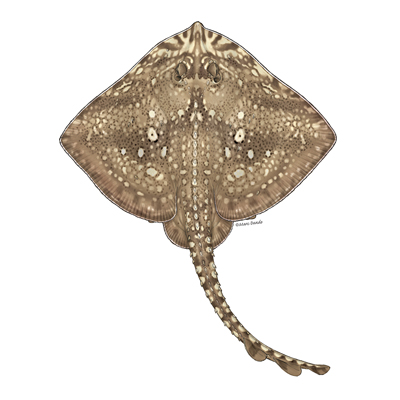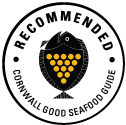

The thornback ray is a common member of the skate family found in Cornish waters. It gets its name from numerous thorn like spines, which are modified ‘skin teeth’ on its upper surface and along the tail. Often marketed as 'skate wings' which is a catchall term for many species of local rays. Be sure to ask your fishmonger which species you are buying as some are less sustainable than others.
The thornback is a medium sized ray of the skate family. Like all skates Its biology makes it vulnerable to over fishing as it grows slowly and produces a small number of large eggs (in egg cases known as mermaids purses) each year. recent information from ICES shows that off Cornwalls north coast stocks of thornback rays are healthy and fishing pressure is within sustainable limits,meaning they are the best choice. We have far less data to go by for the south coast so avoid thornback ray from this area. It is important that you are carefull when buying ray as once skinned they cannot be identified so always ask to see the fish before it is skinned to avoid buying unsustainable ray wings. Management is poor as ray fisheries are limited only by a mixed species quota. There are issues with by catch in net fisheries for ray and with impact on the seabed with trawl fisheries. It is not recommended that you buy skate wings that are smaller than 22cm
A total of 29 tonnes of thornback rays were landed to Cornish ports in 2021, with a value of £38k (MMO data).
Updated July 2023

North Coast (areas 7f and g)
Gill nets are lightweight nets made of nylon (monofilament) fishing line that are anchored to the seabed and are used to catch fish by entangling the gills.
Learn more
North Coast (areas 7f and g)
Demersal trawls are large nets that are pulled through the water with the bottom edge of the net touching the seabed. At each edge the net is pulled open by metal ‘trawl doors’. Sometimes referred to as Otter trawling.
Learn more
North Coast (areas 7f and g)
Beam trawls are nets attached to a steel beam that holds the net open. The belly of the net is made of chains and the upper surface of the net is mesh. Beam trawlers pull two nets along the seabed simultaneously.
Learn moreSouth Coast area 7e
Demersal trawls are large nets that are pulled through the water with the bottom edge of the net touching the seabed. At each edge the net is pulled open by metal ‘trawl doors’. Sometimes referred to as Otter trawling.
Learn moreSouth Coast area 7e
Beam trawls are nets attached to a steel beam that holds the net open. The belly of the net is made of chains and the upper surface of the net is mesh. Beam trawlers pull two nets along the seabed simultaneously.
Learn moreSouth Coast area 7e
Gill nets are lightweight nets made of nylon (monofilament) fishing line that are anchored to the seabed and are used to catch fish by entangling the gills.
Learn moreCornwall Good Seafood Guide rates fish on sustainability using a scale of 1 to 5.
1, 2 and 3 are recommended, Fish to avoid are rated 5.
We use the system devised by the Marine Conservation Society (MCS) so our scores are comparable with the scores produced by MCS for the UK and fisheries from all around the world. For more information on scoring click here.
Thornback rays are an inshore species of skate and are the most common species in Cornish waters. They are medium sized with females growing up to 130cm in length. Thornback rays are known to return to a specific location in order to breed or feed. They are a relatively slow growing species that mature late and produce a relatively small number of eggs each year. Females can grow to 118cm in length and 18kg in weight, while males can reach 98cm in length. Females mature between 60 and 85cm while males mature between 60 and 77cm (in both cases corresponding to an age of 5 to 10 years). The species has a maximum recorded age of 16 years.
MMO landings data






Cornwall Good Seafood Guide is underpinned by the Marine Conservation Society (MCS) Good Fish Guide. The first UK consumer guide to sustainable seafood. For more information visit www.fishonline.org
Cornwall Good Seafood Guide is here to help us all make sustainable seafood choices. Choices that will help us keep the oceans healthy and Cornish fishers' futures safe. This website is funded by Cornwall Wildlife Trust. If you would like to make a meaningful difference to the health of our oceans, please consider making a donation to the Cornwall Wildlife Trust Ocean Emergency fund. Your donation will help safeguard these remarkable environments, ensuring that they continue to thrive for generations to come. Together, we can be stewards of the seas and champions for a healthier, more sustainable future.